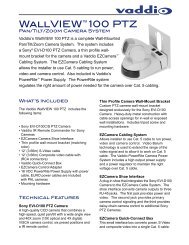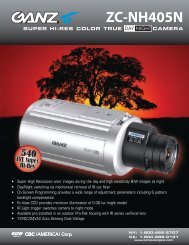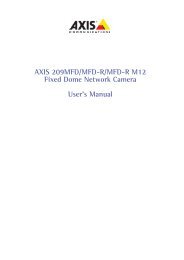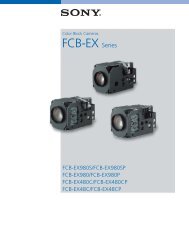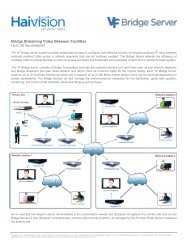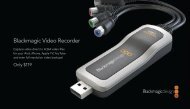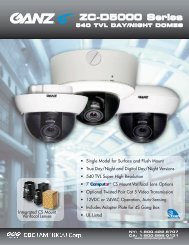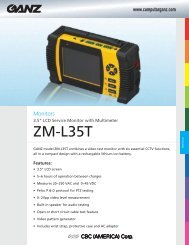AXIS 231D+/232D+ Network Dome Camera User's Manual
AXIS 231D+/232D+ Network Dome Camera User's Manual
AXIS 231D+/232D+ Network Dome Camera User's Manual
Create successful ePaper yourself
Turn your PDF publications into a flip-book with our unique Google optimized e-Paper software.
<strong>AXIS</strong> <strong>231D+</strong>/<strong>232D+</strong> - Glossary of Terms63and among commercial application developers.MAC address (Media Access Control address) - A MACaddress is a unique identifier associated with a piece ofnetworking equipment, or more specifically, its interfacewith the network. For example, the network card in acomputer has its own MAC address.<strong>Manual</strong> iris - This is the opposite to an autoiris, i.e. thecamera iris must be adjusted manually to regulate theamount of light allowed to reach the image sensor.Mbit/s (Megabits per second) - A measure of the bit rate,i.e. the rate at which bits are passing a given point.Commonly used to give the "speed" of a network. A LANmight run at 10 or 100 Mbit/s. See also Bit rate.Monitor - A monitor is very similar to a standard televisionset, but lacks the electronics to pick up regular televisionsignals.Motion JPEG - Motion JPEG is a simplecompression/decompression technique for networked video.Latency is low and image quality is guaranteed, regardlessof movement or complexity of the image. Image quality iscontrolled by adjusting the compression level, which in turnprovides control over the file size, and thereby the bit rate.High-quality individual images from the Motion JPEGstream are easily extracted. See also JPEG.Megapixel - See Pixel.MPEG (Moving Picture Experts Group) - The MovingPicture Experts Group develops standards for digital videoand audio compression. It operates under the auspices of theInternational Organization for Standardization (ISO). TheMPEG standards are an evolving series, each designed for adifferent purpose.MPEG-2 - MPEG-2 is the designation for a group of audioand video coding standards, and is typically used to encodeaudio and video for broadcast signals, including digitalsatellite and Cable TV. MPEG-2, with some modifications, isalso the coding format used by standard commercial DVDmovies.MPEG-4 - MPEG-4 is a group of audio and video codingstandards and related technology. The primary uses for theMPEG-4 standard are web (streaming media) and CDdistribution, conversational (videophone), and broadcasttelevision.Most of the features included in MPEG-4 are left toindividual developers to decide whether to implement themor not. This means that there are probably no completeimplementations of the entire MPEG-4 set of standards. Todeal with this, the standard includes the concept of"profiles" and "levels", allowing a specific set of capabilitiesto be defined in a manner appropriate for a subset ofapplications.Multicast - Bandwidth-conserving technology that reducesbandwidth usage by simultaneously delivering a singlestream of information to multiple network recipients.Multiplexer - A multiplexer is a high-speed switch thatprovides full-screen images from up to 16 analog cameras.Multiplexers can playback everything that happened on anyone camera with no interference from the other cameras onthe system.<strong>Network</strong> connectivity - The physical (wired or wireless)and logical (protocol) connection of a computer network oran individual device to a network, such as the Internet or aLAN.NWay - NWay is a telecommunications protocol used withEthernet networking devices (such as router and switch) toautomatically negotiate the highest possible commontransmission speed between two devices.NTSC (National Television System Committee) - NTSC isthe television and video standard in the United States. NTSCdelivers 525 lines at 60 half-frames/second.OEM (Original Equipment Manufacturer) - This is adesignation for companies that manufacture equipmentwhich is then marketed and sold to other companies undertheir own names.PAL (Phase Alternating Line) - PAL is the dominanttelevision standard in Europe. PAL delivers 625 lines at 50half-frames/second.PEM (Privacy Enhanced Mail) - An early standard forsecuring electronic mail. The PEM-format is often used forrepresenting an HTTPS certificate or certificate request.Ping - Ping is a basic network program used diagnosticallyto check the status of a network host or device. Ping can beused to see if a particular network address (IP address orhost name) is occupied or not, or if the host at that addressis responding normally. Ping can be run from e.g. theWindows Command prompt or the command line in Unix.Pixel (Picture element) - A pixel is one of the many tinydots that make up a digital image. The color and intensity ofeach pixel represents a tiny area of the complete image.PoE (Power over Ethernet) - Power over Ethernet providespower to a network device via the same cable as used for thenetwork connection. This is very useful for IP-Surveillanceand remote monitoring applications in places where it maybe too impractical or expensive to power the device from apower outlet.PPP (Point-to-Point Protocol) - A protocol that uses aserial interface for communication between two networkdevices. For example, a PC connected by a phone line to aserver.PPTP (Point-to-Point Tunnelling Protocol) - A protocol(set of communication rules) that allows corporations toextend their own corporate network through private"tunnels" over the public Internet. In this way a corporationcan effectively use a WAN (Wide Area <strong>Network</strong>) as a largesingle LAN (Local Area <strong>Network</strong>). This kind of



